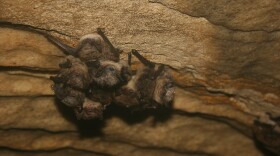New Hampshire’s Bat Population is still sliding – fast – thanks to the invasive fungus, White Nose Syndrome.
White Nose syndrome has been present in Europe for a while, but it was first found in New Hampshire in 2009. It didn’t take long to start doing harm
“In 2010 we had some huge losses. It was really quite scary,” says Emily Preston, a biologist Fish and Game.
She says, as the disease started to accelerate, biologists decided to pull the plug on bat surveys. They reasoned disturbing the animals in the abandoned mines where they spend the winter would lead to even higher mortality.
But this winter they went back for the first time in three years. It was kind of like walking into and abandoned city or the set of a post-apocalyptic Hollywood movie.

There used to be 3,230 bats in the states four biggest hibernating colonies; this year’s count found 16. Two of what had been the most common species – the northern long-eared and the little brown bat – were missing entirely.
“In the top of the mines there are old holes where they would drill in to put the dynamite, and the Northern Long-eared bats used to pack themselves into these little holes and you were trying to count their little noses to try to figure how many bats there were in there,” says Preston, remembering bat-counts before white nose, “and all of them were empty [this year], there were no bats in them anymore, and it was so depressing.”
Also depressing is the fact that white nose is extremely difficult to combat. The disease is incredibly contagious, particularly among cave hibernating bats.
“When they gather together, it’s very similar to the daycare theory, when you have one sick child you bring it in to a population of susceptible children and you can spread the disease that way,” says Anne Ballman, biologist with the National Wildlife Health Center.
And white nose doesn’t even need a host, since it can live on the moist walls of the hibernacula. “It has been demonstrated that the fungus itself will persist at a site once it’s contaminated, for many seasons even if the bat population is drastically reduced,” tells Ballman.
The only treatment that has worked so far is repeatedly rubbing each individual bat with an anti-fungal ointment, and even that has only worked in the lab.
The fungus itself grows into the bats skin tissue, especially in the wings. It messes with their ability to regulate their body temperature and moisture and causes them to wake up from hibernation, making them run through their fat stores.
“When they’re infected with white-nose syndrome they are waking up every six days,” says Preston, “Basically what they are dying from is starvation and dehydration because of the fact that they have burnt through their stored energy.”

But it can also just cause lesions, and eventual, tiny cardiac arrest.
So far, with no clear way to fight the disease, wildlife officials are taking for some standard countermeasures – keeping people out of the caves in the winter, and asking spelunkers to disinfect their gear. And they want anyone who has survivors of the epidemic roosting in their house in the summer to find a way to coexist with them.
But ultimately if bats are going to recover in New Hampshire, it’s all about the long game, which hinges on those very few bats that are still hanging on in Granite State mines.
“We’re hoping that they will pass on whatever-that-thing-is that has allowed them to survive,” says Preston.
Biologists will be watching for that adaptation, whatever it is, so to presumably will the bats.








